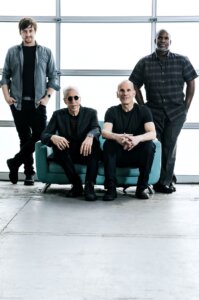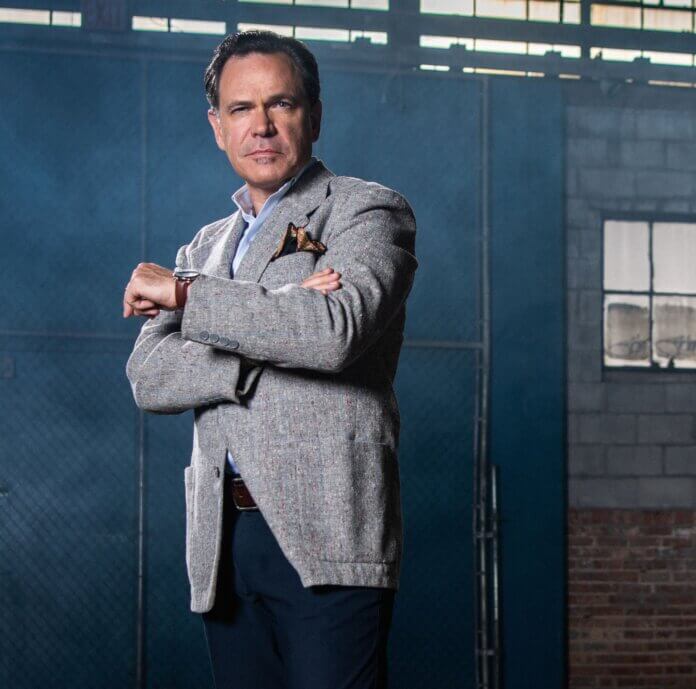Some repertoires are not simply performed – they must be lived. Weather Report’s is one of them. Their music mixed rigor and vision, technique and spirituality, transforming fusion into more than just a style: into a language, into a horizon. Decades later, Celebrate Weather Report is not a mere tribute but a bold gamble – to restore those songs to the human voice, to words, to flesh. Kurt Elling, intellectual crooner and acrobat of vocal jazz, takes that risk and places himself at the center of the challenge.
Widely regarded as one of the most original voices in contemporary jazz, Elling is renowned for his refined style and mastery of vocalese – the art of writing lyrics to famous instrumental solos, from Wayne Shorter to Pat Metheny (for whom he famously penned the lyrics to “Minuano”). His interpretations weave vocal technique, literary sensibility, and improvisation, with references to poets like Rilke and Neruda. A two-time Grammy winner (2010 and 2021), Elling has collaborated with Herbie Hancock, Jon Hendricks, Charlie Hunter, and the Yellowjackets. His recent projects – SuperBlue and Wildflower with Sullivan Fortner – blend jazz and funk in a contemporary idiom.
Formed in 1981 as a studio band for a Robben Ford album, the Yellowjackets went on to become one of the most iconic groups in modern fusion. Their prolific discography and shifting lineup have carried them across four decades, while maintaining a recognizable sound – sophisticated, electric, and always open to dialogue between jazz, R&B, and orchestral writing. Today the band consists of Russell Ferrante (keyboards, the only founding member still active), Bob Mintzer (saxophones, who joined in 1990), Dane Alderson (electric bass), and Will Kennedy (drums, who was with the group in the 1990s). On July 10 in Bergamo, they will join Kurt Elling for the Italian premiere of Celebrate Weather Report.
In the United States, the project has taken shape with a more acoustic, chamber-like formation, with contributions from Joey Calderazzo, Mike Moreno, Essiet Okon Essiet, and Peter Erskine, the band’s former drummer. In Europe, and particularly in Bergamo, the project will take on a more distinct fusion profile, thanks to the Yellowjackets’ unmistakable electric DNA. Two different approaches, but both animated by the same passion for reinvention.

Kurt, it is a pleasure to have you on Musica Jazz. I wrote a book on Weather Report some years ago, so this conversation has a special resonance for me, especially now that you are revisiting their music with Celebrate Weather Report. How important is this connection for you?
I never approached the project as a way to create a personal connection. I was drawn to the compositions, the stories, the personalities, and the atmosphere of that music as a natural extension of my artistic research. In jazz, the music written by great instrumentalists often feels beyond the imagination or scope of singers of their time. The innovations Weather Report introduced in the 1970s were too new for most to assimilate – even for many instrumentalists. The same was true with Parker, Coltrane, and Monk. Maybe I am just the singer with the skills and attention to do it now. I feel like I came along at a moment when Weather Report’s material could finally be understood and adapted for voice. It was a privilege to receive approval from the heirs of Wayne, Zawinul, and Pastorius to use my lyrics. But Weather Report doesn’t need me to amplify their legacy.
You had already performed Weather Report songs with added lyrics in the past. How do you relate to that work today, and how has it influenced this project?
Having written lyrics before gave me an advantage. I didn’t have to start from scratch, and that saved time. It allowed me to focus on pieces that would highlight the band – incorporating electric elements, improvisation, faster tempos, less obvious melodies. In the future, I would love to write more for their repertoire, because there are so many stories waiting to be told from a singer’s perspective. But that requires time and focus, which my schedule rarely allows.
What approach is needed to add a voice to music that originally had no vocals?
As a lyricist, I begin with research. I try to tune into the composer’s emotional dimension. I ask myself: what was the intent behind this melody? What story did he want to tell? Sometimes I only have the title and a few biographical details. Other times, an interview offers more clues. When sources are scarce, I rely on intuition, while always trying to stay faithful to the spirit of the piece.
How important is Peter Erskine’s presence, as a direct witness to Weather Report’s history?
It’s thrilling to have him involved. His perspective is rooted in the band’s history, and his musicality is extraordinary in any context. I had the privilege of working with him on Flirting with Twilight back in 2001. Offstage, he’s generous with anecdotes, reflections, and advice. To have him by my side is a great honor.
In “A Remark You Made,” Shorter’s saxophone is deeply moving, but it is Pastorius’s lyricism that leads into your “Time to Say Goodbye.” Do you feel closer to Shorter’s or Zawinul’s writing?
I prefer to think of each composer as having a unique perspective, rhythmic awareness, and melodic vision.
“Three Views of a Secret” is both lyrically profound and technically demanding. How do you prepare for such challenges?
My preparation has taken all 57 years of my life. Much of what I do is physically demanding, but that strength must always serve the song. While writing, I can sometimes anticipate the more athletic passages and shape the lyrics accordingly. But it’s always the music that leads – its intensity determines the direction the words must take.
In “Continuum,” your lyrics seem to both enhance the original and open something new. What inspired you?
I was inspired by Jaco’s way of playing and writing, and also by a text I once heard from bassist Red Mitchell for “All the Things You Are.” It said:
You are your greatest composition.
The one people hear when they hear your name.
You are your spirit’s own physician.
You are the one who heals yourself.
As a daily game,
You can’t create yourself – that job’s been done.
You can compose yourself – it’s kind of fun.
You are the people you turn to.
You are the one who does what you do.
Your greatest work of art is yourself.
That message has always stayed with me. It’s powerful.
In Bergamo, you will perform with the Yellowjackets, while in the U.S. you worked with more acoustic groups. How does your approach change?
The instrumentation isn’t radically different. The main change will be Bob Mintzer on sax instead of Mike Moreno on guitar. My approach will not shift – I’ll bring intensity and purpose no matter what. It’s not the instruments that change the intensity, but the musicians themselves. Believe me, whether Joey Calderazzo is at a keyboard or an acoustic piano, the fire is the same.
How do audiences respond to electric versions of pieces like “Continuum” or “Palladium”?
As I said, the instrumentation doesn’t really alter the essence.
You’ve given voice to Pat Metheny’s “Minuano (Six Eight)” and other instrumental works. How do you make that transformation happen? And are there other pieces you dream of putting into words?
I’m always searching for compositions to adapt. Finding them is not the hardest part – the challenge is hearing an authentic message within them and shaping words that blend naturally with the melody. The transcription itself can be complex. Then comes the work of learning to sing it with nuance, technique, and emotional transparency. Sometimes it takes years to get it right.
Celebrate Weather Report is more than a tribute – it is a ritual of rewriting. Elling does not sing about the past; he interrogates it. He refuses nostalgia, creating new narratives and new “songs” out of instrumental architectures. The space between memory and invention, groove and poetry, has rarely been explored with such elegance. The legacy of Weather Report is not a relic – it is still living matter. And it sings.
by Alessandro Traverso
